Anyone with a regular fitness and sports regime knows that keeping an eye out for anything that can help in recovery is smart. These days, there are plenty of different recovery options, from heat packs to ice baths. But using red light therapy, or RLT, is a majorly beneficial tool for fitness fans. Better still, there’s ample scientific evidence to support its use in fitness as it offers a wealth of different benefits. That being said, it needs to be used in conjunction with other important fitness-based elements such as nutrition, adequate sleep, and a proper training program.
What is red light therapy?
Red light therapy stimulates the healing body processes using red and near infrared light. It is based on the principle of light wavelengths particularly focusing on the red and near-infrared spectrum. This spectrum of light can pass through the skin to change the body at the cellular level. There are some key features to understand when discovering the power of RLT.
The wavelength RLT uses is the 620–750 nm spectrum, which is about 2-3 mm in depth of tissue penetration. As such, it’s a great option for being effective against superficial tissues disorders such as skin inflammation and wounds. Near-infrared wavelengths penetrated further, and at 800-1000 nm, penetrate the skin to 2-5 cm in depth. As such, this is good for deep tissue healing and recovery specifically for muscles, joints, and bones.
Using RLT has many effects on the body as a whole. It increases ATP (adenosine triphosphate) production, which is catalyzed in the mitochondria during the process. As such, cell function and repair are enhanced through RLT. Triggering vasodilation, and increasing oxygen circulation and delivery to damaged tissues helps to promote the healing process. It also modulates the pathways regarding inflammation, helping to reduce it as well as any inflammation-related pain. Finally, RLT promotes collagen production, which is essential when it comes to tissue repair and regeneration.
Reasons to use RLT in your routine
There are many benefits of red light therapy, and these can help people meet their fitness goals. Here are some of the benefits:
- Enhanced muscle recovery: RLT helps to speed up the natural healing process of the body, specifically after a strenuous workout. It stimulates the cellular repair mechanisms, which can reduce delayed-onset muscle soreness (DOMS).
- Improved performance and endurance: RLT can also be used before an exercise session, and when doing so, can help to increase muscle strength and output. It can help in resistance toward muscle fatigue by boosting the production of ATP, which is the main energy source for cells.
- Reduced inflammation and pain: RLT has a great anti-inflammatory effect, and can help to alleviate muscle and joint pain. This is ideal for athletes who are experiencing chronic conditions or are in the injury recovery process.
- Faster healing: RLT has also been shown to reduce the ‘return to play’ time for different musculoskeletal injuries such as sprains, tendonitis, and strains.
- Better quality sleep: RLT usage is linked to improved sleep quality as it helps to regulate the melatonin production and circadian rhythms. These are both crucial when it comes to general recovery and overall performance in sports and fitness.
What to think about when using RLT
RLT is an emerging treatment so there are still some considerations to think about. First though, the use of RLT is completely safe. There are no known side effects when used as directed. Using it is a non-toxic form of treatment as it’s not invasive nor as harsh as some topical treatments can be. Importantly though, RLT should only be used in conjunction with other fitness tools and is not to be used as a replacement for proper diet, hydration and rest.
It is also key to use RLT consistently once beginning a treatment plan. Results are best seen over time with long-term usage. This means it should be performed multiple times a week over many weeks rather than as a single-use therapy. The effectiveness of the treatment also depends on the device, wavelength, and specific dose. This is important as more is not necessarily better, as it really depends on the treatment and requirements. These devices are now increasingly accessible as an at-home device which allows fitness enthusiasts the option to try out this therapy in comfort.
With careful use, this scientifically-backed treatment can really offer an edge for those focussed on their fitness. It’s a way to help optimize training routines and recovery, especially when used correctly as an enhancement method to a solid fitness foundation.

